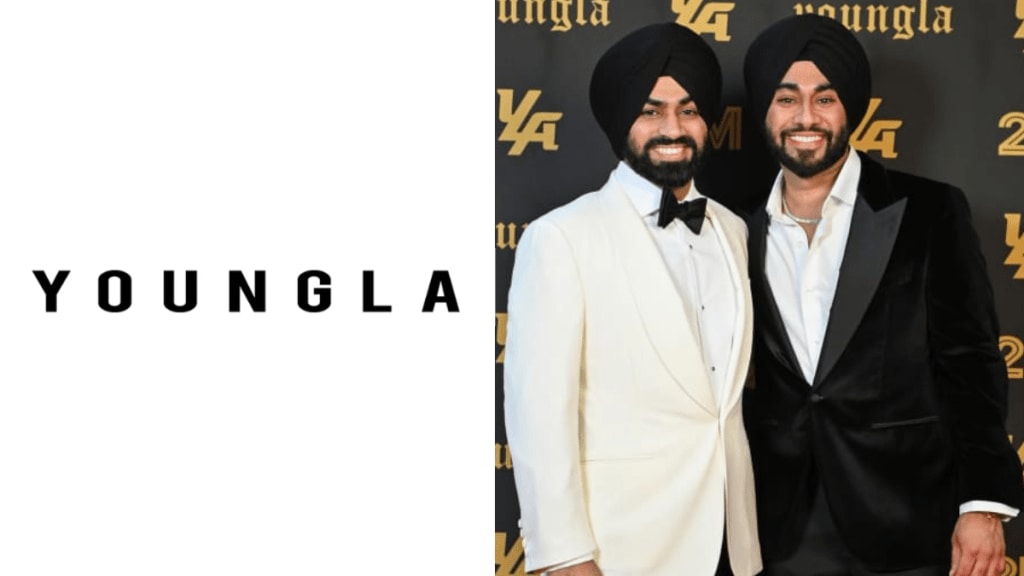In just over a decade, YoungLA has grown from a side hustle selling miscellaneous goods on eBay to one of the fastest-rising names in activewear, powered less by traditional advertising and more by a finely tuned influencer engine.
Founded in 2014 by brothers Dashmeet and Gurmer Chopra, the Los Angeles–based brand now reports $176 million in revenue. But its trajectory is as much about media strategy as it is about apparel.
Origins in resale, and a leap to apparel
Born in India, the Chopras immigrated to the United States as children after their grandfather’s dying wish prompted their father to move the family to New Jersey. There, their father sold souvenirs to New York tourist shops before relocating the family to California for work.
In Los Angeles, the brothers hustled, selling iPhone cases on Craigslist and later running an eBay/Amazon resale operation out of their parents’ home. In 2016, after quitting an auditing job at Ernst & Young, Gurmer doubled down on the business with Dashmeet. That year, the brothers netted just under $500,000 on $5,000 in seed money.
By 2017, they had launched their first original product, men’s gym shorts, under the name “YoungLA,” a nod to their eBay username inspired by a DJ they liked. Instagram marketing soon followed, including the $800 purchase of the @YoungLA handle. Within a year, they had 10,000 followers.
The drop model and influencer machine
YoungLA’s turning point came in the late 2010s when it leaned into a direct-to-consumer “drop” model, releasing small, limited-run collections every two weeks. According to Forbes, it now takes the brand eight to nine months to design, manufacture (primarily in China), and bring an item to market. Drops typically include eight to ten styles, with a handful selling out in minutes.
The strategy mirrors streetwear brands like Supreme, using scarcity to maintain full-price sales. “You could call it artificial scarcity, but it encourages people to pay full price,” retail analyst David Swartz told Forbes. The approach is high-risk: sales depend on sellouts, yet overstocking can force markdowns that undermine the model.
Alongside this, YoungLA has built an aggressive influencer network spanning bodybuilders, UFC fighters, lifestyle creators, and gaming personalities. According to Forbes, influencers can earn a 15% commission per sale plus base fees of $2,000–$10,000 per post, with top-tier partners like Chris Bumstead driving major traffic. These arrangements blur the line between sponsorship and employment, locking influencers into yearlong contracts.
Growth and expansion
The pandemic accelerated YoungLA’s rise, with sales jumping from $6 million in 2020 to $35 million in 2021, $90 million in 2022, and $150 million in 2023. Collaborations have included Arnold Schwarzenegger, Tyson Fury, Jon Jones, and Gold’s Gym. While the brand has operated exclusively online for most of its history, it plans to open its first retail location in October at Los Angeles’ Westfield Topanga mall.
Despite its financial momentum, YoungLA has faced criticism. Product quality reviews are mixed, with some customers citing inconsistency. The company has also weathered controversies, including an athlete scandal involving animal abuse, allegations of copying designs, and internal conflicts with influencers. Cultural perceptions of the brand’s core demographic have occasionally sparked online debate.
A brand built for the social media age
YoungLA’s rise underscores the power and volatility of influencer-led, scarcity-driven commerce. Without wholesale partnerships or a traditional retail footprint, the company relies on constant social media buzz, limited drops, and a tightly controlled narrative to keep customers engaged. Whether this formula can sustain $176 million in sales, and beyond, will depend on YoungLA’s ability to manage both its cultural cachet and the controversies that come with it.

